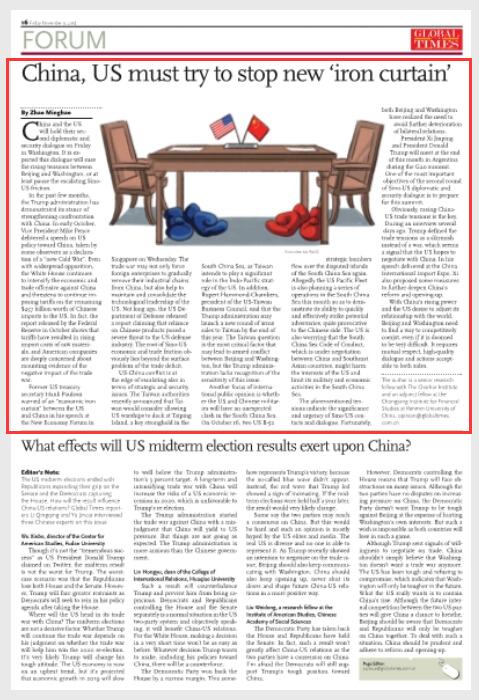Major Power Relations
Your Present Location: PROGRAMS> Major Power RelationsZhao Minghao: China, US must try to stop new ‘iron curtain’
By Zhao Minghao Source: Global Times Published: 2018-11-08
China and the US will hold their second diplomatic and security dialogue on Friday in Washington. It is expected this dialogue will ease the rising tensions between Beijing and Washington, or at least pause the escalating Sino-US friction.

In the past few months, the Trump administration has demonstrated its stance of strengthening confrontation with China. In early October, Vice President Mike Pence delivered a speech on US policy toward China, taken by some observers as a declaration of a "new Cold War". Even with widespread opposition, the White House continues to intensify the economic and trade offensive against China and threatens to continue imposing tariffs on the remaining $257 billion worth of Chinese imports to the US. In fact, the report released by the Federal Reserve in October shows that tariffs have resulted in rising import costs of raw materials, and American companies are deeply concerned about mounting evidence of the negative impact of the trade war.
Former US treasury secretary Hank Paulson warned of an "economic iron curtain" between the US and China in his speech at the New Economy Forum in Singapore on Wednesday. The trade war may not only force foreign enterprises to gradually remove their industrial chains from China, but also help to maintain and consolidate the technological leadership of the US. Not long ago, the US Department of Defense released a report claiming that reliance on Chinese products posed a severe threat to the US defense industry. The root of Sino-US economic and trade friction obviously lies beyond the surface problem of the trade deficit.
US-China conflict is at the edge of escalating also in terms of strategic and security issues. The Taiwan authorities recently announced that Taiwan would consider allowing US warships to dock at Taiping Island, a key stronghold in the South China Sea, as Taiwan intends to play a significant role in the Indo-Pacific strategy of the US. In addition, Rupert Hammond-Chambers, president of the US-Taiwan Business Council, said that the Trump administration may launch a new round of arms sales to Taiwan by the end of this year. The Taiwan question is the most critical factor that may lead to armed conflict between Beijing and Washington, but the Trump administration lacks recognition of the sensitivity of this issue.
Another focus of international public opinion is whether the US and Chinese militaries will have an unexpected clash in the South China Sea. On October 16, two US B-52 strategic bombers flew over the disputed islands of the South China Sea again. Allegedly the US Pacific Fleet is also planning a series of operations in the South China Sea this month so as to demonstrate its ability to quickly and effectively strike potential adversaries, quite provocative to the Chinese side. The US is also worrying that the South China Sea Code of Conduct, which is under negotiation between China and Southeast Asian countries, might harm the interests of the US and limit its military and economic activities in the South China Sea.
The aforementioned tensions indicate the significance and urgency of Sino-US contacts and dialogue. Fortunately, both Beijing and Washington have realized the need to avoid further deterioration of bilateral relations.
President Xi Jinping and President Donald Trump will meet at the end of this month in Argentina during the G20 summit. One of the most important objectives of the second round of Sino-US diplomatic and security dialogue is to prepare for this summit.
Obviously, easing China-US trade tensions is the key. During an interview several days ago, Trump defined the trade tensions as a skirmish instead of a war, which seems a signal that the US hopes to negotiate with China. In his speech delivered at the China International Import Expo, Xi also proposed some measures to further deepen China's reform and opening-up.
With China's rising power and the US desire to adjust its relationship with the world, Beijing and Washington need to find a way to competitively coexist, even if it is doomed to be very difficult. It requires mutual respect, high-quality dialogue and actions acceptable to both sides.
The author is a visiting fellow at the Chongyang Institute for Financial Studies at Renmin University of China.























































































 京公网安备 11010802037854号
京公网安备 11010802037854号





